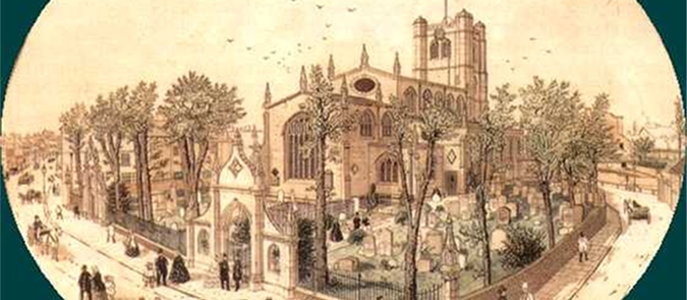History

Saxon Beginnings
Newbury had its beginning from a Saxon settlement known as 'Ulvritone', located south of the River Kennet. At that time, part of what is now the Parish of Newbury was north of The Kennet in the Parish of Speen (Spinae), owned by The Manor of Speen.
The first historical reference to the town appears in the Ecclesiastical History of England and Normandy, by Ordericus Vitalis, in which he stated that Bernard of Neufmarche gave the Church of Speen to the Priory of Aufay in Normandy in 1079. The rent from the land belonging to it and the revenue of 'New Bourg' was to be paid yearly at Michaelmas. Though still part of the Manor of Speen, Newbury had become a town by the middle of the 11th century. With its natural advantages of a waterway and its ford over the River Kennet (where the neighbouring roads converged) Newbury supplanted Speen as a place of importance.
William the Conqueror
The first mention of a church on this site was in a grant of "William King of the English" (William the Conqueror) to the newly-founded Abbey of St Pierre de Preaux in Normandy in 1086. Confirmed by a Charter of King Henry II (circa AD 1187), the grant mentions "the patronage of the Church of St Nicolas of Newbury" being given by Ernuif of Hesding to the said Abbey. The grant of lands to an Abbey was seldom made at the time of the actual foundation and building of a church. Therefore, Ernulf, Lord of forty-eight manors under the gift of William the Conqueror, is said to be the original founder of the Church of St Nicolas towards the end of the 11th century. The only trace of this first church is some of the north porch foundations discovered outside the present building. The present building is therefore considerably larger than the Norman structure and covers the rest of the old foundations.
15th Century
The patronage of the Rectory of Newbury remained in the possession of the Abbey of St Pierre de Preaux in Normandy (in the Diocese of Lisieu) until the wars of the 15th century, when the estates of foreign priories in England were granted by Parliament to the Crown. The King gave the advowson of St Nicolas to Sir Thomas Erpingham, Lord Warden of the Cinque Ports. He had commanded the English troops in France, and obtained permission from the King to grant his life interest in the advowson and possessions of the Abbey of Preaux in England to the Carthusian Abbey of Witham in Somerset (1413).
16th Century
The church was entirely rebuilt, probably between the years 1509 and 1533. It is in the architectural style of the late Perpendicular period. The presence of certain devices in the stonework, in particular the pomegranate device (the apple of Grenada) and the portcullis device (which appears on the Tudor royal Escutcheon) indicates that the church was built during the marriage of Henry VIII and Catherine of Aragon, which ended in divorce during 1533.
In Thomas Fuller's 'History of the Worthies of England', published in 1663, it is stated: "John Winchcombe, commonly called Jack of Newberry... built the church of Newberry, from the pulpit westward to the tower inclusively, and died about the year 1520".
From the dissolution to today
At the dissolution of the monasteries all their estates became vested in the Crown. The patronage of the Rectory of Newbury continued in the gift of the Crown except during the period of Cromwell's Commonwealth. During this period (in 1644), the Church of St Nicolas was used as a prison and a hospital by the Parliamentary Army after the second Battle of Newbury. In 1854, eighteen years after Berkshire had been transferred from the Diocese of Salisbury to that of Oxford, an Order in Council made over the presentation of the Rectory of Newbury to the Bishop of Oxford, where it remains to this day.
The discovery of the Norman remains of the church
From the Newbury Weekly News, 27 August 1921
During some drainage operations now being carried out on the north side of the Parish Church, the piers of an entrance porch, extending seven feet on either side were disclosed, showing that there was a large doorway on this spot, either entirely closed in or pierced with small windows. There is a six feet opening between the two side walls, which are some little distance eastward of the existing entrance. The foundations are constructed of flints and rough blocks of clunch-close-grained hard limestone of great irregularity in size and shape, evidently grouted in with hot mortar, forming a most compact and solid footing. This clunch was obtained from the extensive quarries of Burghclere, which formerly provided much of the material for local churches. Mr. Walter Money, F.S.A., to whom we are indebted for this information, states that a Norman church was known to have existed on this spot, and was given by William the Conqueror to the Abbey of Preaux, in Normandy, by grant dated 1086. Mr Money also noted 'The Norman porch stood 12ft in advance of the north front of the present church. The existing porch projects 9ft 6in. The width of the original Norman doorway of the porch was 6ft. Possibly the late Perpendicular church was largely built on the old foundations. Much church and other old materials were certainly used in the present structure'.
|